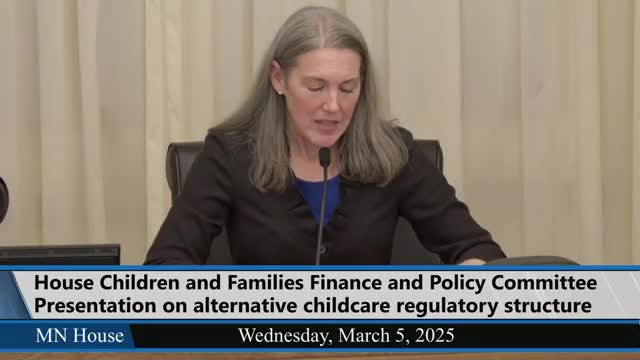Childcare providers face rising insurance costs due to delayed licensing updates
March 06, 2025 | 2025 Legislature MN, Minnesota
Thanks to Scribe from Workplace AI , all articles about Minnesota are free for you to enjoy throughout 2025!

This article was created by AI using a video recording of the meeting. It summarizes the key points discussed, but for full details and context, please refer to the video of the full meeting. Link to Full Meeting
One of the key issues addressed was the current system's tendency to present violations in a way that lacks context, leading to misunderstandings about the severity of issues. A representative noted that while some citations, such as the presence of hazardous materials, may sound alarming, they often do not reflect the actual risk involved. This lack of clarity can create unnecessary panic among families and damage the reputation of childcare providers, potentially resulting in a loss of clientele.

Before you scroll further...
Get access to the words and decisions of your elected officials for free!
Subscribe for FreeMoreover, the meeting underscored the financial implications of these licensing practices. Amy Jo Van Cullen, an insurance professional, submitted a letter expressing concern that broad licensing citations without context are making it increasingly difficult for providers to obtain and maintain liability insurance. As insurers assess risk based on licensing records, providers facing vague or severe citations may find themselves with skyrocketing premiums or even being dropped from coverage altogether. This trend not only threatens the viability of childcare businesses but also places additional financial burdens on families, as providers may pass on increased costs.
The committee discussed the potential benefits of implementing a risk-based system for licensing, which could provide insurers with clearer information about the actual risks associated with childcare providers. Such a system could help stabilize insurance premiums and support the sustainability of childcare services in the state. However, the implementation of this system has faced delays, contributing to ongoing frustrations within the provider community.
Additionally, the committee reviewed the updated licensing standards, which have been met with mixed reactions. While there were positive aspects in the initial draft released last spring, many providers felt that the proposed standards were overly complicated and punitive rather than supportive. The delay in finalizing these standards has further exacerbated tensions, as providers have expressed a desire for a more collaborative approach to licensing.
In conclusion, the discussions during the committee meeting highlighted critical challenges facing childcare providers in Minnesota, particularly regarding licensing practices and insurance coverage. As the state navigates these issues, the need for timely and effective solutions remains paramount to ensure the stability of childcare services and the well-being of families relying on them. The committee's next steps will be crucial in addressing these concerns and moving towards a more supportive regulatory framework.
Converted from House Children and Families Finance and Policy Committee 3/5/25 meeting on March 06, 2025
Link to Full Meeting
Comments
View full meeting
This article is based on a recent meeting—watch the full video and explore the complete transcript for deeper insights into the discussion.
View full meeting




